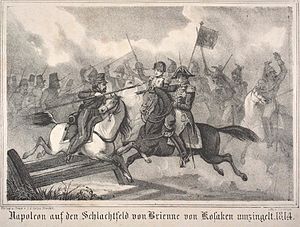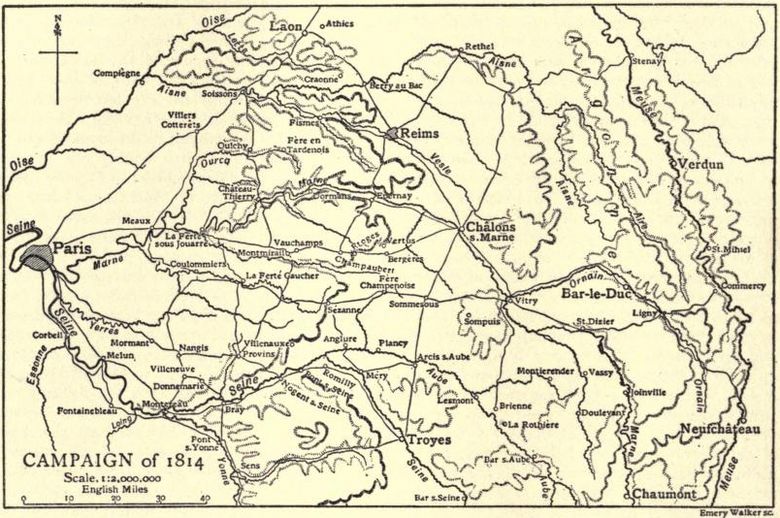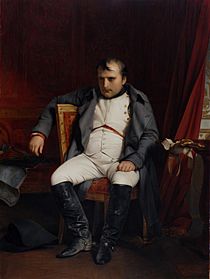Battle of Brienne facts for kids
Quick facts for kids Battle of Brienne |
|||||||
|---|---|---|---|---|---|---|---|
| Part of the Campaign of France of the Sixth Coalition | |||||||
 Napoleon was nearly taken by the Cossacks after the battle, but was saved by French general Gaspard Gourgaud. |
|||||||
|
|||||||
| Belligerents | |||||||
| Commanders and leaders | |||||||
|
|||||||
| Strength | |||||||
| 36,000 | 28,000-30,000 | ||||||
| Casualties and losses | |||||||
|
3,000–4,000 killed, wounded, or captured | ||||||
The Battle of Brienne happened on January 29, 1814. It was a fight between the French army, led by Emperor Napoleon, and the combined forces of Prussia and Russia. These Allied forces were commanded by Prussian Field Marshal Gebhard Leberecht von Blücher.
The battle was very intense and lasted into the night. The French managed to capture the château (a large country house) and almost caught Blücher. However, they couldn't force the Russians out of the town of Brienne-le-Château. Napoleon himself, who was fighting on a battlefield for the first time in 1814, also came very close to being captured. Early the next morning, Blücher's troops quietly left the town. They retreated to the south, leaving the French in control of the area.
In late 1813, two large Allied armies, with about 300,000 soldiers, broke through France's defenses. By January 1814, Napoleon decided to lead his armies himself. He hoped to defeat Blücher's army before it could join up with the main Allied army. This main army was led by Austrian Field Marshal Karl Philipp, Prince of Schwarzenberg. Napoleon's plan didn't work, and Blücher managed to escape and meet up with Schwarzenberg. Just three days later, the two Allied armies, now with 120,000 soldiers, attacked Napoleon in the Battle of La Rothière.
Contents
Why Did the Battle Happen?
The Situation in Late 1813
In November 1813, about 70,000 French soldiers returned to France. They had survived a very difficult campaign in Germany. Emperor Napoleon had left many French soldiers behind in German cities. These soldiers were trapped by enemy forces. Also, all of Napoleon's German allies had switched sides and joined the Sixth Coalition against him.
In other parts of Europe, French forces were also busy. Marshal Jean-de-Dieu Soult and Marshal Louis Gabriel Suchet defended the border with Spain. Napoleon's step-son, Eugène de Beauharnais, led 50,000 troops defending the Napoleonic Kingdom of Italy from the Austrian Empire. There were also French soldiers in Belgium, the Netherlands, and eastern France.
Allied Plans Against Napoleon
The leaders of the Allied forces had different ideas. Czar Alexander I of Russia and King Frederick William III of Prussia wanted to remove Napoleon from power. But Emperor Francis I of Austria, who was Napoleon's father-in-law, was not so eager. He also worried that a weaker France might make Russia and Prussia too strong. Prince Schwarzenberg, the Austrian commander, was careful and waited to see what would happen. On the other hand, Blücher was very keen to defeat Napoleon as soon as possible.
The Allied leaders met in Frankfurt to make a plan. Their plan was for Blücher to cross the middle Rhine River with 100,000 troops. His job was to keep Napoleon busy. At the same time, Schwarzenberg would cross the upper Rhine with 200,000 men. He would move towards Langres, attacking the French from the side.
Napoleon tried to stop this huge attack. He placed Marshal Claude Perrin Victor with 10,000 troops on the upper Rhine. Marshal Auguste de Marmont and Horace Sebastiani were on the middle Rhine. Marshal Jacques MacDonald was on the lower Rhine. Other troops were in Holland and Belgium. Napoleon also had his best soldiers, the Old Guard, ready.
Allied Armies Advance into France

On December 22, 1813, parts of Schwarzenberg's army crossed the upper Rhine into France. Blücher crossed the middle Rhine on December 29. Napoleon's defenses quickly fell apart. Victor left Nancy, and Marmont retreated to Metz. By January 17, Marmont, Ney, and Victor were behind the Meuse River. Blücher's army moved very quickly, covering about 75 miles in nine days.
At first, Napoleon didn't realize how many Allied soldiers there were. He thought Schwarzenberg had 50,000 troops and Blücher had 30,000. By the end of January, he understood the real numbers. He decided to stop Blücher's and Schwarzenberg's armies from joining up. The combined Allied armies would have 120,000 soldiers for the Battle of La Rothière on February 1. On that day, the Allies had 85,000 men and 200 cannons. Napoleon had only 45,100 soldiers and 128 cannons.
Napoleon left his brother Joseph Bonaparte in charge of Paris. He then went to Châlons-sur-Marne on January 26, 1814. He had several groups of soldiers with him, including those led by Victor, Marmont, and Ney. Other forces were still on their way.
Napoleon wanted to keep his presence a secret. He gave his army four days' worth of food. They marched towards Saint-Dizier, where he thought Blücher was. But when they arrived, Blücher had moved southwest to Brienne-le-Château. At Saint-Dizier, French cavalry pushed back some Russian soldiers on January 27. Napoleon knew Brienne well because he had studied there as a boy. He hoped to trap Blücher's forces against the Aube River before more Allied troops could arrive.
Allied Forces Gather
On January 28, Napoleon moved towards Brienne in three groups. One group marched from Vitry-le-François. The main group, the Imperial Guard, marched from Saint-Dizier. The third group marched from Wassy. Marmont stayed behind to keep other Prussian forces busy. Napoleon sent messages to other French commanders to help with his plan. However, Russian Cossacks captured all three messengers. They delivered Napoleon's plans directly to Blücher.
By the morning of January 29, Blücher knew Napoleon was coming. He knew Napoleon had gotten between him and another Prussian force. Blücher was aware that Napoleon was approaching with 30,000 to 40,000 soldiers. The roads were very muddy because of a thaw. But Napoleon's soldiers still managed to reach their positions by nightfall on January 28.
Blücher was in Brienne with his infantry corps. Another Russian corps was further west. Other Allied forces were spread out nearby. Schwarzenberg's headquarters was at Chaumont.
The Battle of Brienne Begins
Blücher was warned just in time about the French attack. He called back his troops from Lesmont to Brienne. He had about 6,000 infantry, 3,000 cavalry, and 1,600 hussars ready. Blücher placed his infantry in Brienne and his cavalry on the plain nearby.
The French advance guard, led by Hippolyte Piré, met some Cossack regiments. More French cavalry arrived, and they pushed back the Cossacks and other Russian horsemen. During this cavalry fight, a French general, Charles Lefebvre-Desnouettes, was wounded.
By 3:00 PM, the Russian cavalry retreated through Brienne. They regrouped on the Russian right side. The French chase stopped when they met three battalions of Russian light infantry, who were in a square formation. More Russian troops began to arrive in Brienne around this time.
Napoleon waited until 3:30 PM for more of his infantry to arrive. Then, he ordered a general attack. For about an hour, the French and Russian soldiers fought hard, but neither side gained much ground. Between 4:00 and 5:00 PM, another French division joined the battle. They managed to push deeper into the town at first. However, the French commander, Ney, stopped their advance because of problems elsewhere.
A Close Call for Napoleon
Blücher noticed that a French division was not supported by cavalry. He sent 40 squadrons of Russian cavalry to attack the French left side. The Russian horsemen scattered the French division and captured eight cannons. In the confusion, a group of Cossacks almost captured Napoleon himself! But Napoleon quickly gathered his shaken soldiers and led them back into the fight. Nightfall prevented a worse disaster for the French.
By this time, all of the Russian troops were on the field. Blücher and his chief of staff, August Neidhardt von Gneisenau, thought the fighting for the day was over. They went to the château. But they were almost captured when some of Victor's French infantry, led by Louis Huguet-Chateau, quietly slipped up to the château using an unguarded road and seized it. These 400 French soldiers also captured four cannons, but they soon lost them to a Russian counterattack.
Napoleon ordered more French divisions to storm Brienne. This attack was not successful at all. The French general Decouz was badly wounded and died later. Another general was killed right away. To protect his supply wagons, Blücher ordered his troops to clear the French from Brienne and retake the château. After fierce fighting, the Russians pushed the French out of most of the town. However, they failed to recapture the château. Finally, French cavalry tried to help, but it was useless.
At midnight, Blücher ordered his troops to retreat. Two hours later, he told another Russian general to withdraw. The Russian cavalry stayed in position until morning. The French didn't realize the Russians had left at first. They finally occupied Brienne at 4:00 AM.
What Was the Outcome?
Historians say that both sides lost about 3,000 to 4,000 soldiers. This includes those killed, wounded, or captured. The French also lost 8 to 11 cannons.
The battle was not a clear victory for Napoleon. Even though the French took the town, they couldn't stop Blücher from joining up with Schwarzenberg's main Allied army. Two French generals, François Louis Forestier and Decouz, were wounded in the battle and died later from their injuries.



